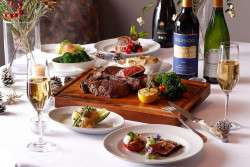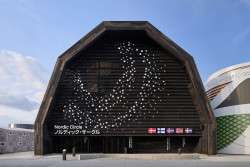
September 8, 2011
Keats
Enjoy the last of the summer wine in the backyard of this Yutenji eatery
By Metropolis
Originally published on metropolis.co.jp on September 2011

I’m having a late lunch at one of the communal picnic tables at Keats, a restaurant named for the Yutenji English Romantic poet. Across from me is an elderly couple with their grandson, who looks about five. His fist is wrapped around a spoon, which he is using to shovel in mouthfuls of apple-tofu-custard pie. “I like this place,” he says to his grandmother sipping wild herbal tea. “You don’t see many restaurants like this.”
He’s right—in typically insular Tokyo, you don’t. Keats is set up in a restored traditional house, a rare and wonderfully tactile wooden structure. The dining room is actually in what would have been the backyard, now covered with wood planks worn smooth, though some foliage peaks out at the edges and vines run up the beams. The ceiling is a mix of plastic sheeting and bamboo shades; the walls are a mosaic of salvaged wood and more bamboo. One whole side is left open along the shopping street that runs toward Yutenji Station, making this people-watching seat at the end of the communal table one of the most popular. The cross-breeze and a few strategically placed fans keep things surprisingly cool even during the summer heat.
If you’ve been mourning yet another summer in the city without a backyard, mourn no longer. Keats is open until midnight and manages to segue neatly from the family-friendly lunch hour to sultry evening cocktails when just a handful of spotlights provide the lighting. There’s also a lounge on the second floor with vintage furniture, such as velvet armchairs, for more intimate gatherings.
The food at Keats has macrobiotic tendencies, though this shouldn’t be interpreted as bland vegetarian fare. There is plenty of fish and meat on the menu and more than a few Mediterranean-inspired dishes. House specialties include cocido (¥1,200), a traditional Spanish dish of meat, chickpeas and vegetables simmered for hours in their own broth. The result—falling-apart soft pork, tender carrots and broth-infused cabbage—shows off the flavor of the quality ingredients used in the kitchen. There is also paella (¥1,600) with zakkoku (millet) instead of plain rice; this comes out a little soupy, but at least the assorted shellfish remain juicy. These entrées, and others, are brought to the table directly from the stove in cast iron skillets with dishtowels still wrapped around the handles.
Salads, Caesar (¥1,100) and Niçoise (¥1,800), come in big wooden bowls and are enough to serve the table. A generous sampler plate of starters (¥1,800) includes rockfish escabeche, garlic pesto whole-wheat toast, curling folds of lean Iberico ham, and salads of seasonal vegetables. There is a small, but well-considered selection of organic wines available (from ¥600 for a glass), plus beer and cocktails.
Lunch is a humbler affair than dinner, with a choice of set meals (grilled fish or vegetable curry, for example). Again the presentation is simple, utilitarian: the legions of tiny, fussy dishes associated with teishoku are dispensed with and the neat pile of brown rice and a colorful assortment of salads are served directly on the wooden tray. Creative, subtly sweet desserts, including chiffon cake made with black sugar and misukaru (a powdered blend of grains from Korea), and a crème brulée studded with tiny grains of kibi mochi (made from millet and rice), are served all day.
Some of what is served at Keats is available, albeit in raw form, at the shop in the main house. Here you can find jars of wild rice, hand-woven baskets, and sometimes vegetables. There is also a take-away counter, a bakery, and on our most recent visit we spotted thermoses of milkshakes. All of this indicates that Keats intends to be more than just a restaurant; perhaps it is aiming for something reminiscent of a 1950s-style neighborhood drug store complete with soda fountain, though with more rarified offerings. Judging by the number of bicycles parked out front, the clientele is mostly local, but perhaps that’s only because more people haven’t discovered it yet.







